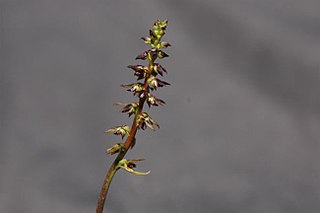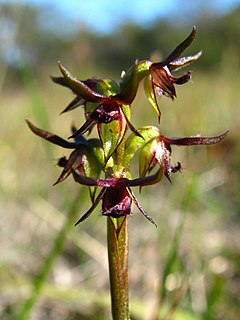
Genoplesium plumosum, commonly known as the Tallong midge-orchid or plumed midge-orchid, is a species of orchid endemic to New South Wales. It is a small orchid only known from a few sites near the towns of Tallong and Wingello on the Southern Tablelands and is only relatively easy to find for about a month, when it flowers. It has been classified as "Endangered" under the EPBC Act.

Genoplesium nigricans, commonly known as mallee midge orchid, is a species of orchid endemic to Australia. It is a terrestrial herb with a single leaf mostly surrounding the stem, and up to 50 tiny, greenish flowers with a deep maroon-coloured labellum and often have a fruity fragrance. Australian authorities use the name Corunastylis tepperi, a widespread species which has been confused with Corunastylis nigricans, a species with purplish brown flowers and which only occurs on Kangaroo Island and the Eyre Peninsula.
Genoplesium rufum, commonly known as the rufous midge-orchid, is a species of orchid endemic to New South Wales. It has a single thin, wiry leaf and up to twenty five drooping, pinkish or reddish flowers on a flowering stem which is fused to the lower part of the leaf. It was formerly thought to range from Queensland to South Australia and Tasmania but specimens in other states are now assigned to Genoplesium clivicola.
Genoplesium nudiscapum, commonly known as the bare midge orchid, is a small terrestrial orchid endemic to Tasmania. It has a single thin leaf fused to the flowering stem and up to twenty small, green and reddish-brown flowers. It was thought to be extinct, since it had not been seen since 1852 but was rediscovered in 2008. The species has also been described as occurring on continental Australia. Australian authorities use the name Corunastylis nudiscapa for the Tasmanian endemic but Genoplesium nudiscapum is used by the World Checklist of Selected Plant Families.

Genoplesium morrisii, commonly known as the bearded midge orchid and known as Corunastylis morrisii in Australia, is a small terrestrial orchid endemic to south-eastern Australia. It has a single thin leaf fused to the flowering stem and up to fifteen small, dark purplish-black or green and purple flowers.
Genoplesium acuminatum, commonly known as the pointed midge orchid and as Corunastylis acuminata in Australia, is a small terrestrial orchid endemic to eastern Australia. It has a single thin leaf fused to the flowering stem and up to sixteen small, hairy, greenish purple to brownish purple flowers. It is found in coastal and near-coastal parts of New South Wales and Queensland.

Genoplesium archeri, commonly known as the elfin midge orchid and as Corunastylis archeri in Australia, is a small terrestrial orchid endemic to south-eastern Australia. It has a single thin leaf fused to the flowering stem and up to fifteen small, hairy, yellowish green flowers with purple stripes. It grows in a wide range of habitats in New South Wales, Victoria and Tasmania.
Genoplesium bishopii, commonly known as the Gibraltar Range midge orchid and as Corunastylis bishopii in Australia, is a small terrestrial orchid endemic to New South Wales. It has a single thin leaf fused to the flowering stem and up to thirty small, dark purplish red flowers. It grows in heathy forest and on the edges of swamps in the Gibraltar Range National Park.
Genoplesium brachystachyum, commonly known as the Rocky Cape midge orchid or short-spike midge orchid and as Corunastylis brachystachya in Australia, is a small terrestrial orchid endemic to Tasmania. It has a single thin leaf fused to the flowering stem and up to twelve small, green to brownish green, and reddish flowers. It usually grows in heath in rocky places near the coast.

Corunastylis ciliata, commonly known as the fringed midge orchid, is a small terrestrial orchid endemic to southern Australia. It has a single thin leaf fused to the flowering stem and up to fifteen small, green to greenish yellow flowers with purplish markings and a reddish purple labellum. It was formerly included with Corunastylis archeri, and C. ciliata is regarded as a synonym of Genoplesium archeri by the World Checklist of Selected Plant Families. Plants in this species have fewer, more erect flowers, a less-hairy labellum and have different coloration than C. archeri.
Genoplesium firthii, commonly known as Firth's midge orchid and as Corunastylis firthii in Australia, is a small terrestrial orchid endemic to Tasmania. It has a single thin leaf fused to the flowering stem and up to six small, yellowish green or reddish flowers with a red labellum. It grows in coastal heath and scrub and is currently known only from a single population of about twelve plants near Coles Bay.
Genoplesium morinum, commonly known as the mulberry midge orchid and as Corunastylis morina in Australia, is a small terrestrial orchid endemic to New South Wales. It has a single thin leaf fused to the flowering stem and up to twenty crowded, dark reddish purple flowers. It has been known as "mulberries on sticks".
Genoplesium ruppii, commonly known as Rupp's midge orchid and as Corunastylis ruppii in Australia, is a small terrestrial orchid endemic to eastern Australia. It has a single thin leaf fused to the flowering stem and up to twenty five small, hairy green flowers with a purple labellum.
Genoplesium sagittiferum, commonly known as the horned midge orchid and as Corunastylis sagittifera in Australia, is a small terrestrial orchid endemic to New South Wales. It has a single thin leaf fused to the flowering stem and up to ten small, yellowish-green flowers with a hairy reddish labellum.
Genoplesium sigmoideum, commonly known as the Dave's Creek midge orchid, is a small terrestrial orchid endemic to a small area in the Lamington National Park in Queensland. It has a single thin leaf fused to the flowering stem and up to twenty dark red flowers with a hairy labellum.
Genoplesium tectum, commonly known as the Cardwell midge orchid, is a small terrestrial orchid endemic to a small area in north-eastern Queensland. It has a single thin leaf fused to the flowering stem and up to thirty light red flowers with a dark reddish-black, hairy labellum.
Genoplesium turfosum, commonly known as the alpine midge orchid, is a small terrestrial orchid endemic to a small area in the higher parts of New South Wales. It has a single thin leaf fused to the flowering stem and up to twenty five dark purplish-red, crowded flowers with a sparsely hairy labellum.
Corunastylis densa, commonly known as the dense midge orchid, is a small terrestrial orchid endemic to eastern Australia. It has a single thin leaf fused to the flowering stem and up to twenty five densely crowded reddish-brown to dark purplish-brown flowers. It is found between the New England National Park and the Moroka River.
Corunastylis laminata, commonly known as the red midge orchid, is a small terrestrial orchid endemic to New South Wales. It has a single thin leaf fused to the flowering stem and up to twenty bright reddish flowers. It grows in heath and grassy forest in a few places on the South Coast and Central Tablelands.
Corunastylis trifida, commonly known as the blackish midge orchid, is a small terrestrial orchid endemic to New South Wales. It has a single thin leaf fused to the flowering stem and up to twenty five dark purplish-black and green flowers. It grows in heath in scattered places in the Sydney basin.




